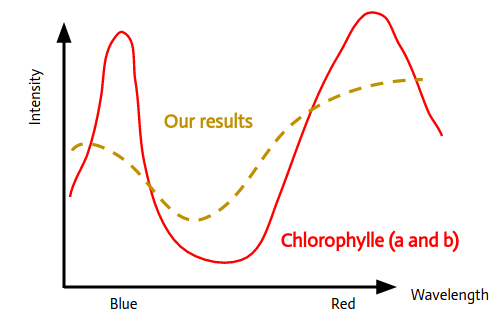Who sees the most ?
Lentils Vs TCS3200
By Nina Guérin, Lara Narbona Sabaté and Adrien Vergès
During one week, our team worked on lentils. The reason? Testing which colors could be sensed by lentils in comparison to a traditional RGB (Red Blue Green) sensor TCS 3200.
Light has a major role in life on Earth: it helps plants to do photosynthesis, it helps us to get vitamin D, it warms Earth enough to allow life...
Light is a wave. The change of its wavelength (the distance between tops of this wave) changes also the color of light. The colors of visible light (as in a rainbow) go from violet (wavelength around 400 nm) to red (wavelength around 800 nm), characterising the visible domain of light.
But light does not refer only to the visible spectrum. There are also other domains of light non-visible by our eyes such the ultraviolet (UV) or infrared (IR).
Wavelength is one of the characteristic used to define a light, but not the only one. We can also precise its intensity, if it is polarised or not, … On our experiment we focused on the wavelength (also known as the color) of light.
We asked ourselves which spectrum of light is perceived by plants, and if a common RGB sensor had a wider range of perception. This is why we decided to compare lentils to a electronical sensor, TCS3200 color sensor. In this experiment, lentils are considered as a biological sensor: an organism (or a part of it) that, with its behaviour, can help to measure different phenomena. For its part, an electronic sensor can also help to measure different phenomena but would be made all by electronical devices.
But… how can lentils actually help in measurements?
Lentils (Lens culinaris) are a type of plants easy to grow and find. The growth of their sprouts, once they are germinated, is quite fast (in 18h they can grow for 2cm according to our experiences).
As all plants, they also do photosynthesis: they use light as a source of energy to their metabolism and therefore to grow. That’s why, when they’ll be exposed to certain light wavelengths, they will grow faster.
Fig 1. Boxes used for the protocol
And the RGB sensor?
A lot of different light sensors exist. They can measure the intensity of light or its color. Since we wanted to know which wavelengths did a common sensor detect, we decided to use the TCS3200 color sensor. Powered by an Arduino, this sensor gives RGB value of the object in front of it captor.
Our experiment
We used 19 boxes (figure 1) in order to isolate lentils from exterior light : we tested 5 different light wavelengths (infrared, red, green, blue and ultraviolet) and for each color, we did 3 replicates. Moreover, we did 2 positive controls (boxes exposed to sunlight, to see what was lentils normal growth rate) and 2 negative controls (boxes kept in the dark, to see what was their minimal growth rate).
We measured how much did the sprouts grow in 18 hours depending on its exposition to light. That could help us to know with which intensity (% of reception) does lentils respond to light.
Data analysing
Fig 2. Intensity of the biological captor 
On figure 2 we can see the trend curve of our results in yellow and chlorophyll reception of light in red. Our results show that lentils grow better under red and IR light. The lowest growth rate occurs under green light.
Those results shows that lentils grow better under red and blue light; as Engelmann’s experience showed (1886). What we can also see is that lentils can sense UV and IR wavelengths (since their growth on those domains was greater than the one of the negative control).
The question is : is the sensor TCS3200 better on detecting those wavelengths? To answer that question, we collected the values given by the electrical sensor when put in the same conditions as lentils (figure 3).
Fig 3. Percentage of red, blue and green detected under red and blue light.
The results showed above were obtained with red and blue LEDs. Green was not recognised by the sensor: indeed, the sensor recognized green color as sunlight.
Conclusion
Comparing the biological data and the electrical data does not make any sense. At the beginning we expected to compare both sensors but we realised that data do not allow to do so. Because sensor’s data underline its lack of precision and prevent us to quantify the intensity of its values. Anyway, we managed to understand that lentils grows faster under red and blue light, and that color sensor TCS3200 cannot perceive the green light nor UV or IR.
If you want to know more:
Do not hesitate to check this video in order to see what is phototaxis and this video in order to learn more about Engelmann experiment.
If you want to know more about light polarisation
If you are interested in our storify : StorifyIf you want to have an access to our sources and more :Notre github

No comments:
Post a Comment